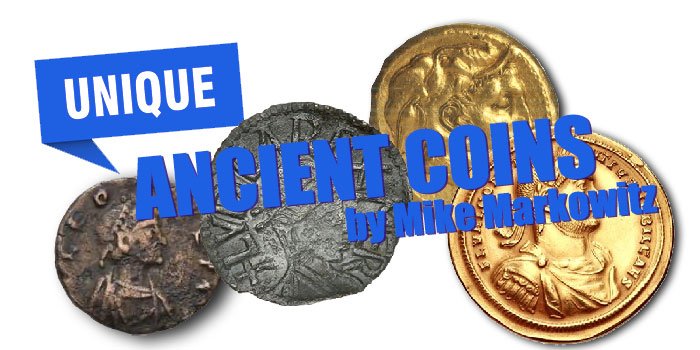
CoinWeek Ancient Coin Series by Mike Markowitz for CoinWeek …..
“This is a very rare coin; only two examples known! Unfortunately, the only guy in the world who cares has the other one.”
— Classic Numismatic Joke (source unknown)
“Unique” means one of a kind. The ultimate rarity. The rarest anything can be.
This designation, however, is fragile; there’s always the chance that another authentic specimen will turn up. And because of this, professional numismatists prefer expressions like “apparently unique”, “unpublished”, and “historically important”. But when that Latin word unicum (or the German spelling “unikum”) appears in a catalogue listing, the heart of a classical numismatist beats a little faster.
The value of an ancient coin is determined by three factors: historical interest, eye appeal, and rarity. Any unique coin of Alexander the Great or Cleopatra would be important (a euphemism for “way expensive”) no matter how battered. But a unique provincial copper of an obscure ruler known only to specialists would have little historical interest and probably a modest price tag.
This article will briefly describe a few unique ancient coins from different times and places.
Aitna Tetradrachm
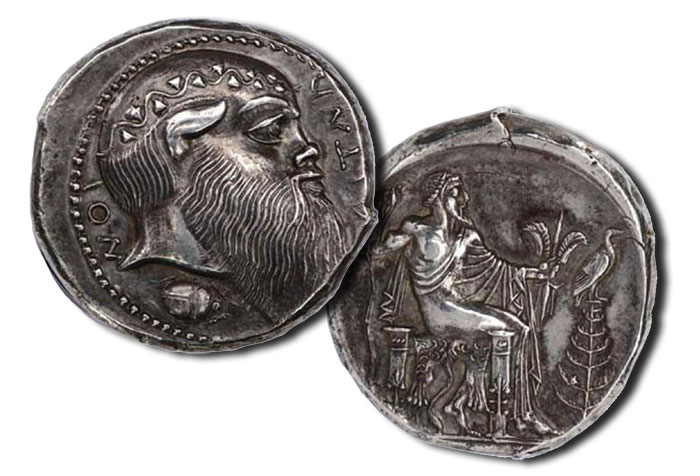
Struck about 465 – 460 BCE at Aitna (now Catania, Sicily), a unique silver tetradrachm has been described as “the Coin of Coins.”[1] It resides in Brussels in the National Library of Belgium collection. On Harlan Berk’s list of the hundred greatest ancient coins, this is #22.
Berk writes:
The coin is one of the best examples of the severe style of Greek art, representing the transition between the stiffer Archaic and the more naturalistic classical styles. The relief is extraordinarily high, the detail amazing, and the composition original. It stands alone as a monument of Greek coinage (Berk, 25).
The obverse is a bearded head of the satyr Silenus, companion of the wine god Dionysus. The rich volcanic soil around Mount Etna still produces superb wines. A small beetle appears below the satyr’s neck, rendered so accurately that entomologists have identified the species as Thorectes marginatus[2].
On the reverse, the god Zeus sits enthroned, holding his signature thunderbolt. Before him, an eagle perches atop a tree–probably Sicily’s magnificent and endangered Nebrodi fir[3].
The anonymous master engraver who created the Aitna tetradrachm is also credited with the superb tetradrachm of nearby Naxos (now Taormina, Sicily), #4 on Berk’s list, of which about 61 examples are known.
Alexander Gold Double Daric
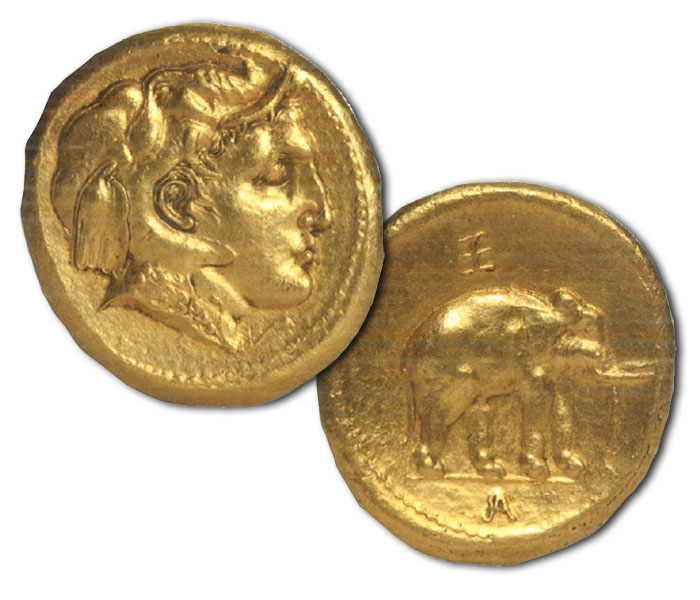
In 1947 a vast hoard estimated at 550,000 coins extending over a period from the fifth century BCE to the second century CE, emerged from a muddy pond near the Afghan village of Mir Zakah, about 88 km (54 miles) southeast of Kabul.
Most of the coins were slowly dispersed in Afghan and Pakistani bazaars. In 1992-93 as Afghanistan disintegrated into civil war, local warlords excavated the site again, extracting tons of coins. Among these was a unique gold double daric of Alexander the Great, initially published by the eminent Sri Lankan historian and numismatist, Osmund Boepearachchi[4].
The coin is controversial; its provenance and authenticity have been debated at length[5].
On the obverse, a beardless male head in high relief with the features of Alexander the Great wears the bizarre “elephant scalp” headdress that symbolized “Conqueror of India”. The reverse depicts an Indian elephant, the Greek letter Xi (“Ξ”) appears above, its meaning unknown, and a monogram composed of the letters “BA” is below (a standard abbreviation for basileus, meaning “king”). Weighing 16.75 grams, the metal is 97.7% gold, 1.8% silver, and 0.4% copper, with traces of platinum and palladium (Holt, 47).
Owned by a Pakistani collector, the coin was exhibited at French museums in 2005.
Arras Gold Medallion
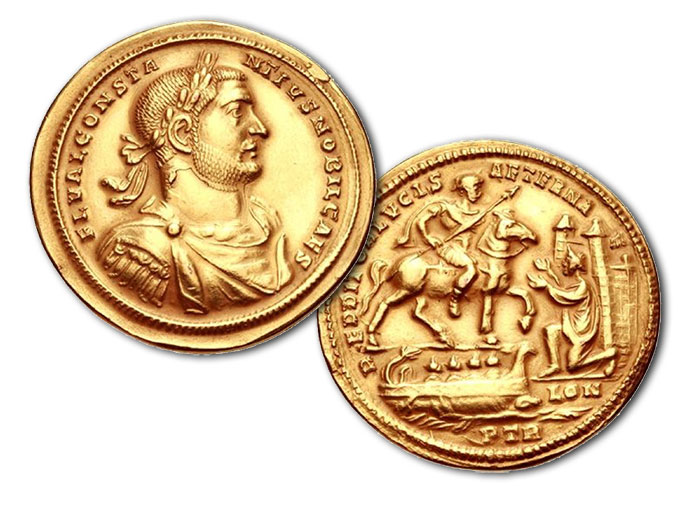
On September 22, 1922, workmen digging near Beaurains, a suburb of Arras in northern France, unearthed a fabulous treasure of gold and silver buried c. 315 CE[6].
Among the treasure was a unique 10-aureus (52.88 gram) gold medallion of Constantius I, co-emperor under Maximian, 293-305, and father of Constantine the Great. It commemorates his defeat of the British usurper Allectus in 296 CE. Struck at the mint of Trier in Germania, the medallion was probably a presentation piece given to a senior military commander.
The obverse bears a stern portrait of Constantius in armor, wearing a victor’s laurel wreath. The Latin inscription FL VAL CONSTANTIUS NOBIL CAES translates as “Flavius Valerius Constantius Most Noble Caesar.” “Caesar” in this era was a title given to co-emperors in the complex “Tetrarchy” that divided power between Eastern and Western emperors, each with a junior co-emperor.
On the reverse, a kneeling woman representing the city of Londinium (now London) welcomes Constantius on horseback at the city gates, while a galley filled with troops rows up the Thames. The inscription REDDITOR LUCIS AETERNA celebrates the conqueror as “Restorer of Eternal Light”. The original is in a museum in Arras; a high-fidelity electrotype replica made in 1927 is in the British Museum[7], though not currently on display.
Abydos Stater
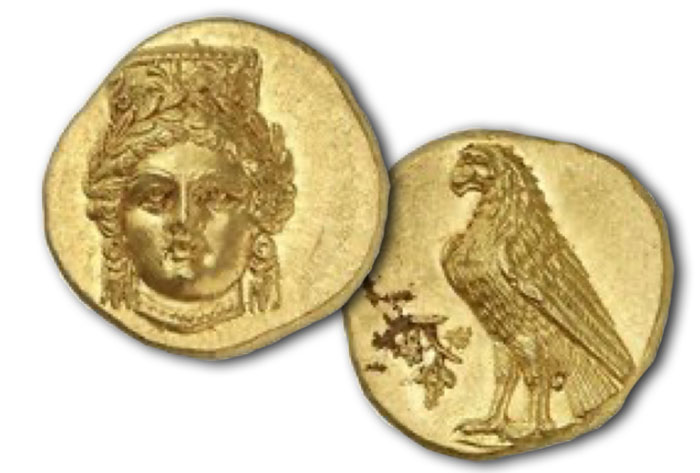
An outstanding million-dollar unique coin is the gold stater of Abydos[8], issued around 330 BCE. Abydos, near modern Çanakkale, Turkey, was located at the narrow crossing point of the Hellespont, one of the straits separating Europe from Asia Minor. Alexander the Great established a mint at Abydos that struck a few remarkable gold staters c. 330 BCE.
The obverse of this coin bears a lovely facing head of Artemis, goddess of the hunt, along with wild animals and the Moon. Artemis wears a cylindrical headdress adorned with curling leaves. On the reverse, an eagle stands beside a branch with vine leaves and a cluster of grapes.
Without inscriptions or monograms, this coin is both elegant and enigmatic.
In a 2010 Swiss auction, it sold for over $1,000,000[9].
Eunos
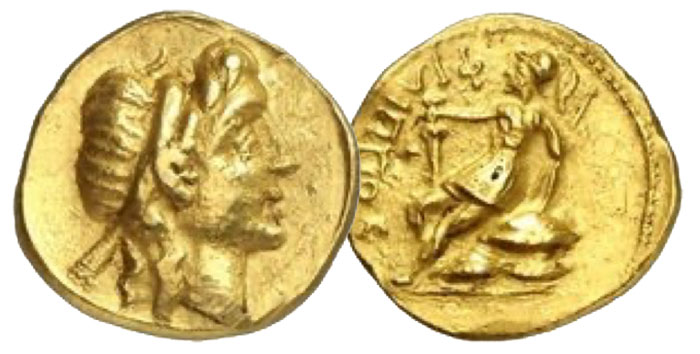
In 135 BCE, slaves in the Roman province of Sicilia (Sicily) rose in revolt. Led by a Syrian slave named Eunos who proclaimed himself king under the name “Antiochus”, the rebels captured the city of Enna and issued their own coins. For three years the “First Servile War”[10] raged until Roman troops captured Eunos in a cave. He died of illness before he could be executed.
A unique gold stater bearing a portrait of Eunos appeared in a 2012 German auction[11]. The reverse shows a seated figure on a pile of captured weapons with the Greek inscription “Philippos”. The most common gold pieces circulating in the Roman Republic were staters of Philip II of Macedon (ruled 359-336 BCE) and philippus became a generic Latin name for any gold coin.
Leo II Nummus
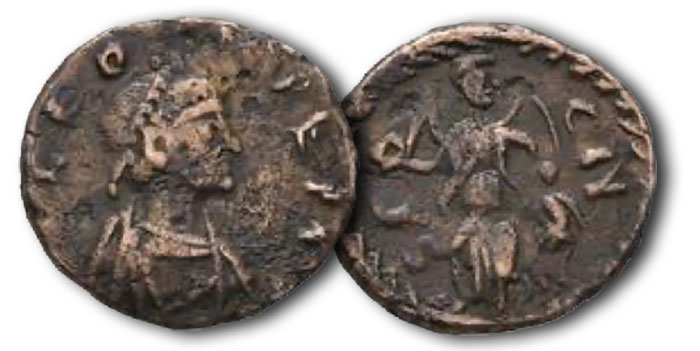
His mother, Ariadne, was the daughter of Emperor Leo I (ruled 457-474). His father Zeno commanded the imperial army. When Leo I died on January 18, 474, his grandson, young Leo II, became the sole emperor. Since he was too young to sign official documents, the Senate made Leo’s unpopular father co-emperor on February 9. Leo II died at the age of seven, leaving Zeno in power.
The nummus was the smallest coin of that era: it took a sack of 7,200 to equal one gold solidus. The unique coin bears an obverse portrait of the child, and the figure of Victory on the reverse.
The cataloguer writes:
It would make sense for this to have been an accession donative, meant to be thrown to the common people at the coronation (the more important guests would have been tossed gold solidi.)[12]
Ludica Penny
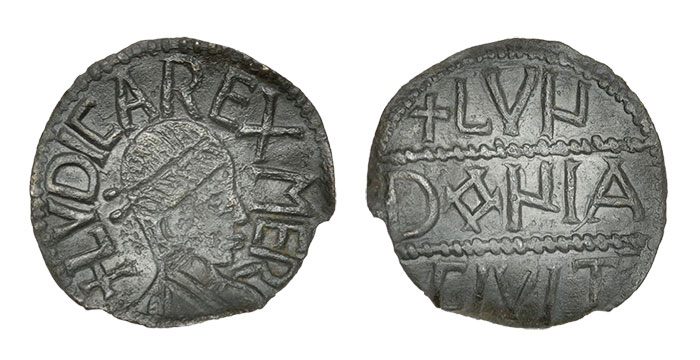
Mercia existed as an independent Anglo-Saxon kingdom in central England from 527 to 879 CE. In January 2016, Andy Hall, a British metal detectorist, discovered a unique and historically significant silver penny of the short-lived Mercian king Ludica who ruled 826-7. It took three years before experts accepted the coin’s authenticity.
The obverse portrait of Ludica is described by the cataloguer as “bold and almost naturalistic in style … it is tempting to see this as a sign of lingering Roman influence on Anglo-Saxon kingship.”[13] The reverse is inscribed LVNDONIA CIVIT[as] “City of London” in clear letters.
Only 10 other coins of Ludica are known and none bear a mint signature. The coin indicates that Mercia, not Wessex, controlled London until some time after Ludica was killed in battle against the East Angles.
In a recent British auction, the coin brought over $41,000.
The UK is one of the only countries on the planet with a sensible antiquities law regime[14]. There, metal detecting is a popular and respected hobby, and the documentation of Britain’s numismatic history is constantly updated by new discoveries.
* * *
Notes
[1] de Callataÿ and Gitler (2004)
[3] https://conifersociety.org/conifers/abies-nebrodensis/
[4] https://en.wikipedia.org/wiki/Osmund_Bopearachchi
[5] Holt (2011) passim
[6] https://en.wikipedia.org/wiki/Beaurains_Treasure
[7] https://www.britishmuseum.org/collection/object/C_B-11477
[8] Not to be confused with an ancient Egyptian city of the same name.
[9] Numismatica Genevensis Auction 6, December 1, 2010, Lot 84. Realized CHF 1,000,000 (about $1,003,110 USD; estimate CHF 350,000).
[10] https://en.wikipedia.org/wiki/First_Servile_War
[11] Gorny & Mosch Auction 207, October 15, 2012, Lot 61. Realized €8,500 (about $10,995 USD; estimate €8,000).
[12] Nomos obolos 15, May 24, 2020, Lot 884. Realized CHF 2,200 (about $2,265 USD; estimate CHF 100).
[13] Dix Noonan Webb Auction 171, March 10, 2020, Lot 138. Realized £32,000 (about $41,381 USD; estimate £10,000 – 15,000).
[14] https://finds.org.uk/treasure
References
Berk, Harlan J. 100 Greatest Ancient Coins. Pelham, AL (2019)
de Callataÿ, François. “The Brussels tetradrachm of Aitna: possibly the most precious ancient coin of the world”, All That Glitters: the Belgian Contribution to Greek Numismatics. Panagiotis P. Iossif (editor). Athens (2010)
de Callataÿ, François and Haim Gitler. The Coin of Coins: A World Premiere. Israel Museum: Jerusalem (2004)
Holt, Frank and Osmund Bopearachchi. The Alexander Medallion: Exploring the Origins of a Unique Artefact. Roqueyroux, France (2011)
Toynbee, Jocelyn. Roman Medallions. New York (1986)




